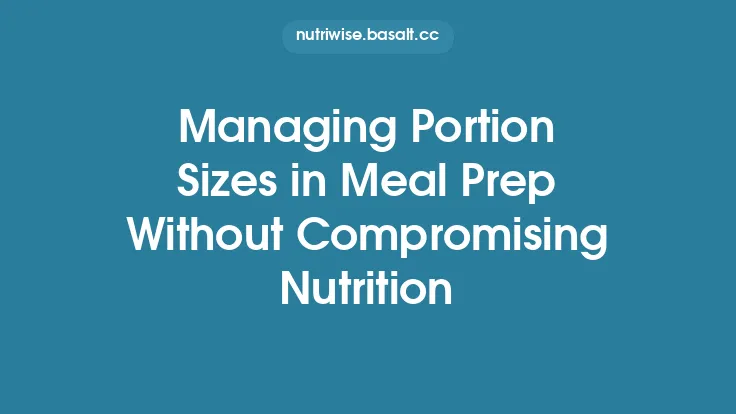Cooking in large batches is more than a time‑saving trick; it’s a strategic approach to stretching every grocery dollar while still delivering nutritious, satisfying meals. By preparing a single, well‑planned pot of food that can be portioned out over several days or weeks, you gain control over both your budget and your nutrition. This article walks through the economics, the science, and the practical steps needed to master economical portion control through batch cooking.
Why Batch Cooking Saves Money
- Reduced Ingredient Waste
When you buy a single, larger quantity of a staple (e.g., beans, rice, or tomatoes) you avoid the “just‑in‑case” purchases that often go unused. Bulk purchases of non‑perishable items typically come with lower unit costs, and the risk of spoilage is minimal.
- Lower Energy Costs
Cooking one large pot or tray uses the same amount of heat as cooking several smaller portions. The oven or stovetop reaches the desired temperature once, and the cooking time per gram of food actually drops because heat transfer is more efficient in a larger mass.
- Economies of Scale in Labor
The time spent on prep—chopping, measuring, cleaning—does not increase linearly with volume. A single 10‑minute chopping session can supply ingredients for a week’s worth of meals, freeing up hours later in the week.
- Predictable Grocery Bills
By anchoring your menu around a few core batch‑cooked dishes, you can forecast ingredient costs with high accuracy, making it easier to stay within a set food budget.
Calculating Cost per Portion
Understanding the true cost of each serving is essential for effective budgeting. Follow these steps:
| Step | Action |
|---|---|
| 1 | List every ingredient with its purchase price and the amount used in the batch. |
| 2 | Convert each ingredient’s price to a per‑unit cost (e.g., $2.50 per 500 g can = $0.005 per gram). |
| 3 | Multiply the per‑unit cost by the quantity used in the recipe to get the ingredient cost for the batch. |
| 4 | Sum all ingredient costs to obtain the total batch cost. |
| 5 | Divide the total batch cost by the number of servings you intend to portion out. |
*Example*: A chili recipe uses 1 kg of ground turkey ($8.00), 2 cans of diced tomatoes ($1.20), 500 g of dried beans ($1.00), and spices ($0.30). Total batch cost = $10.50. If the batch yields 15 servings, cost per portion = $0.70.
Use a simple spreadsheet or a budgeting app that allows custom ingredient entries to automate this process for future batches.
Scaling Recipes Accurately
When you double or triple a recipe, the relationships between ingredients can shift, especially for leavening agents, spices, and thickening components. Keep these guidelines in mind:
- Linear Ingredients: Most proteins, grains, vegetables, and liquids scale directly (2 × quantity = 2 × yield).
- Non‑Linear Ingredients: Salt, pepper, hot sauce, and thickening agents (flour, cornstarch) often need less than a strict linear increase. Start with 75 % of the scaled amount, taste, and adjust.
- Cooking Time Adjustments: Larger volumes may require longer simmering or baking times to achieve the same texture. For stovetop dishes, increase the simmer time by 10‑20 % for each doubling of volume. For oven‑baked items, add 5‑10 minutes per additional inch of depth.
A practical method is to prepare a “master batch” that serves as a reference point. Record the exact quantities, cooking times, and any adjustments made. Future scaling becomes a matter of referencing that master sheet.
Choosing the Right Cookware and Containers
The equipment you use can dramatically affect both the quality of the batch and the cost efficiency of the process.
- Heavy‑Bottom Pots and Dutch Ovens: These distribute heat evenly, reducing the risk of scorching and allowing for gentle, consistent simmering—ideal for soups, stews, and beans.
- Sheet‑Pan Roasters: For large‑scale roasting of vegetables or proteins, a rimmed sheet pan maximizes oven space and promotes even caramelization.
- Portion‑Control Containers: BPA‑free, stackable containers with clear volume markings simplify the portioning step. Look for containers that are both freezer‑ and microwave‑safe to avoid transferring food between dishes.
- Vacuum‑Sealer: While an optional investment, vacuum sealing extends shelf life by up to 50 % compared to standard airtight containers, reducing waste and preserving flavor.
Food Safety and Shelf Life in Bulk Cooking
Batch cooking introduces unique food‑safety considerations because larger quantities stay at temperature longer during cooling and storage.
- Rapid Cooling
- Divide the hot batch into smaller, shallow containers (no deeper than 2 inches) to accelerate cooling.
- Use an ice‑water bath for metal pots, stirring occasionally until the temperature drops below 70 °F (21 °C) within two hours.
- Refrigeration Limits
- Cooked dishes stored in the refrigerator should be consumed within 3‑4 days.
- Label each container with the preparation date to avoid accidental over‑storage.
- Freezing Guidelines
- Most cooked proteins, soups, and stews retain quality for 2‑3 months when frozen at 0 °F (‑18 °C) or lower.
- Avoid freezing dishes with high water‑content vegetables (e.g., lettuce, cucumbers) as they become mushy upon thawing.
- Reheating Safely
- Heat to an internal temperature of 165 °F (74 °C) before serving.
- Stir halfway through reheating to eliminate cold spots, especially in microwaved portions.
Portion Control Techniques for Different Diets
Batch cooking does not mean a one‑size‑fits‑all approach. Tailor portion sizes to meet specific nutritional goals:
- Calorie‑Controlled Diets: Use a kitchen scale to weigh each portion, aiming for a consistent caloric target (e.g., 400 kcal per lunch).
- Macronutrient Balancing: Pre‑portion protein, carbohydrate, and vegetable components into separate containers, then combine at mealtime to hit desired macro ratios.
- Special Dietary Needs: For low‑sodium or low‑sugar plans, keep sauces and seasonings separate. Add them in measured amounts when serving to keep the base batch neutral.
Digital portion‑control apps can sync with your scale, automatically logging calories and macros as you portion out each meal.
Batch Cooking for Diverse Cuisines
A common misconception is that batch cooking limits culinary variety. In reality, many world cuisines lend themselves to large‑scale preparation:
- Mediterranean: Cook a big pot of lentil soup or chickpea stew, then portion with a side of quinoa or whole‑grain couscous.
- Asian: Prepare a bulk batch of stir‑fried vegetables with tofu or tempeh, storing the sauce separately to keep flavors fresh.
- Latin American: Make a large batch of black‑bean and sweet‑potato chili, then serve with a small portion of brown rice or corn tortillas.
- Middle Eastern: Cook a big pot of spiced bulgur wheat or freekeh, then pair with roasted eggplant and a dollop of yogurt.
By rotating the base batch every week and swapping side components, you maintain variety without sacrificing the efficiencies of bulk preparation.
Integrating Batch Cooking into Your Weekly Routine
- Designate a “Batch Day”
Choose a low‑stress day (often Sunday) to shop, prep, and cook. Block 2‑3 hours in your calendar to treat it as a non‑negotiable appointment.
- Pre‑Plan Ingredient Overlap
Select recipes that share core ingredients (e.g., a batch of roasted carrots can serve a soup, a side dish, and a salad topping). This reduces the number of unique items you need to purchase.
- Create a “Portion Calendar”
Map out which meals will be consumed on which days. This visual aid helps you avoid accidental duplication and ensures you use perishable items first.
- Set Up a “Reheat Station”
Keep a microwave or stovetop ready for quick reheating. Having a set of pre‑measured reheating instructions (e.g., “microwave 2 min, stir, then 1 min”) speeds up weekday meals.
Common Pitfalls and How to Avoid Them
| Pitfall | Solution |
|---|---|
| Over‑cooking the batch – leads to mushy textures and nutrient loss. | Use a timer and test doneness early; remember that foods continue to cook slightly during cooling. |
| Inaccurate portion sizing – results in wasted food or unexpected calorie intake. | Invest in a digital scale and portion‑control containers; double‑check with a nutrition app. |
| Flavor flattening – large batches can become bland if seasoning isn’t adjusted. | Add a “flavor boost” component (e.g., fresh herbs, citrus zest) at the time of serving. |
| Improper storage – leads to spoilage and food‑borne illness. | Follow the rapid cooling and labeling guidelines outlined above; keep freezer and fridge organized to locate containers quickly. |
| Monotonous meals – boredom can cause you to abandon the system. | Rotate cuisines, vary side dishes, and experiment with different sauces kept separate until serving. |
Tools and Resources for Efficient Batch Cooking
- Recipe Scaling Calculators – Websites and apps that automatically adjust ingredient amounts based on desired servings.
- Meal‑Tracking Software – Programs that log cost per portion, nutritional data, and inventory levels.
- Smart Kitchen Thermometers – Devices that alert you when a pot reaches target temperature, preventing over‑cooking.
- Label Makers – Print clear, waterproof labels with date, portion size, and reheating instructions.
- Community Recipe Exchanges – Online forums where home cooks share batch‑friendly recipes, often with cost breakdowns.
By integrating these tools into your workflow, you streamline the entire process from planning to plate, reinforcing the economic benefits of batch cooking.
Final Thoughts
Cooking in large batches transforms the kitchen from a daily chore zone into a strategic hub for financial and nutritional control. By calculating true portion costs, scaling recipes with precision, selecting appropriate cookware, and adhering to food‑safety best practices, you can consistently deliver wholesome meals while keeping your grocery bill in check. The flexibility to adapt portions for various dietary goals, combined with the ability to explore a range of global flavors, ensures that batch cooking remains both economical and enjoyable—an evergreen cornerstone of smart, budget‑friendly meal planning.





